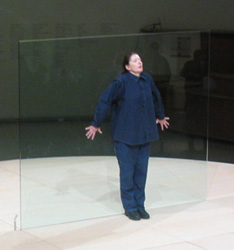Marina Abramović
Marina Abramović (Serbian: Марина Абрамовић, born November 30, 1946) is a Serbian performance artist, who has been a pioneering figure in using the body as both subject and medium in contemporary art. Abramović's work explores the relationship between performer and audience, the limits of the body, and the possibilities of the mind. She has been described as the "grandmother of performance art."
Early Life and Education[edit | edit source]
Marina Abramović was born in Belgrade, in the former Yugoslavia, to parents who were both Partisans during the Second World War. Her early life was marked by a strict and difficult relationship with her parents. She began her art education at the Academy of Fine Arts in Belgrade before moving to Zagreb to continue her studies. It was during this period that she began to explore performance art.
Career[edit | edit source]
Abramović's early works in the 1970s involved performances where she explored elements of ritual and gesture, often putting her own body in situations of risk and pain. One of her most notable early works is Rhythm 10 (1973), where she used a series of 20 knives to rapidly stab at the spaces between her spread fingers.
In 1976, Abramović moved to Amsterdam and met German artist Ulay (Frank Uwe Laysiepen), with whom she formed a long personal and artistic relationship. Together, they performed a series of works exploring the dynamics of relationships and the physical limits of the body. Their collaboration ended in 1988 with a dramatic performance at the Great Wall of China, where they started from opposite ends and walked towards each other, meeting in the middle to say goodbye.
After her separation from Ulay, Abramović continued to explore solo performances. Her work became increasingly focused on the interaction between performer and audience, an exploration of the mind's capabilities, and the use of long durations to affect perceptions of time and space. The Artist is Present (2010), held at the Museum of Modern Art in New York City, is perhaps her most famous solo performance. In this piece, Abramović sat silently at a table in the museum's atrium while visitors were invited to sit directly opposite her, one at a time, for as long as they wished.
Legacy and Influence[edit | edit source]
Marina Abramović has been a key figure in the development of performance art. Her work has challenged the boundaries of art and the capabilities of the body, influencing a generation of artists. She has received numerous awards and honors for her contributions to art, including the Golden Lion for Best Artist at the 1997 Venice Biennale.
Selected Works[edit | edit source]
- Rhythm 10 (1973)
- Rhythm 5 (1974)
- Rhythm 0 (1974)
- Rest Energy (1980, with Ulay)
- The Lovers (1988, with Ulay)
- Balkan Baroque (1997)
- The Artist is Present (2010)
See Also[edit | edit source]
Search WikiMD
Ad.Tired of being Overweight? Try W8MD's physician weight loss program.
Semaglutide (Ozempic / Wegovy and Tirzepatide (Mounjaro / Zepbound) available.
Advertise on WikiMD
|
WikiMD's Wellness Encyclopedia |
| Let Food Be Thy Medicine Medicine Thy Food - Hippocrates |
Translate this page: - East Asian
中文,
日本,
한국어,
South Asian
हिन्दी,
தமிழ்,
తెలుగు,
Urdu,
ಕನ್ನಡ,
Southeast Asian
Indonesian,
Vietnamese,
Thai,
မြန်မာဘာသာ,
বাংলা
European
español,
Deutsch,
français,
Greek,
português do Brasil,
polski,
română,
русский,
Nederlands,
norsk,
svenska,
suomi,
Italian
Middle Eastern & African
عربى,
Turkish,
Persian,
Hebrew,
Afrikaans,
isiZulu,
Kiswahili,
Other
Bulgarian,
Hungarian,
Czech,
Swedish,
മലയാളം,
मराठी,
ਪੰਜਾਬੀ,
ગુજરાતી,
Portuguese,
Ukrainian
Medical Disclaimer: WikiMD is not a substitute for professional medical advice. The information on WikiMD is provided as an information resource only, may be incorrect, outdated or misleading, and is not to be used or relied on for any diagnostic or treatment purposes. Please consult your health care provider before making any healthcare decisions or for guidance about a specific medical condition. WikiMD expressly disclaims responsibility, and shall have no liability, for any damages, loss, injury, or liability whatsoever suffered as a result of your reliance on the information contained in this site. By visiting this site you agree to the foregoing terms and conditions, which may from time to time be changed or supplemented by WikiMD. If you do not agree to the foregoing terms and conditions, you should not enter or use this site. See full disclaimer.
Credits:Most images are courtesy of Wikimedia commons, and templates, categories Wikipedia, licensed under CC BY SA or similar.
Contributors: Prab R. Tumpati, MD





